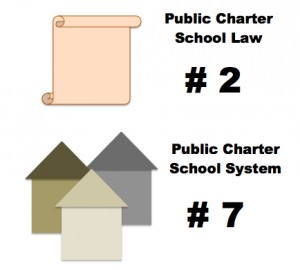Here’s Why Indiana’s Public Charter Schools Are #7 In The Nation
Indiana’s public charter school system is considered one of the best in the nation, anchored by a charter school law ranked second among the 43 states that have such legislation.
This is according to a list of the nation’s healthiest charter school systems, compiled by the National Alliance for Public Charter Schools.
The NAPCS released its inaugural report Wednesday judging states on how well they are implementing their charter school laws. Rankings were based off measurements of growth, quality and innovation in state’s charter sectors.
Combining those metrics, Indiana’s public charter school system came in at number seven out of the 26 states evaluated. The District of Columbia and the state of Louisiana topped the list with the “healthiest” charter school systems.
Even more impressive, the state’s public charter school law ranks second, above 40 other states and the District of Columbia, all which offer similar legislation. Indiana’s law ranks behind only Minnesota, where the nation’s first charter schools appeared in 1991.
Indiana enacted its public charter school law in 2001. Elements of the law that work? According to NAPCS researchers, it:
- doesn’t cap charter school growth,
- includes multiple authorizers, and
- provides a fair amount of autonomy and accountability.
Nick LeRoy, executive director with the Indiana Charter School Board, says credit for the success of Indiana’s law should go to policymakers at both the governor’s level as well as the legislature, who he says have created a good environment to allow for the growth of high-quality charter schools.
“Indiana has taken a very expansive approach to the growth of charter schools and really allowed demand to drive growth,” LeRoy says. “When there is an opportunity for a charter school to launch in a city or district where kids are not getting a good quality education, there’s never been impediments that have been placed in the way from a policy or legal perspective on that.”
However, researchers point out the law provides inequitable funding to charters, something they recommend expanding to increase the impact of student success.
LeRoy says he agrees that funding issues need to be addressed.
“Since charter schools don’t get access to local property taxes for facilities, charters often divert dollars from putting that money towards education and to put it towards facilities,” LeRoy explains. “Since charters are actually producing higher educational outcomes with less dollars, if there were more fairness in the amount of money spent on charter schools versus district schools, what would the results look like at that point?”

Kyle Stokes / StateImpact Indiana
A math teacher leads a lesson on mathematic inequalities at Charter School of the Dunes in Gary. On average, kids in charter schools outperform their traditional public school counterparts in both math and reading.
LeRoy also says a more equitable distribution of funds could help support higher quality charter schools throughout the state. Many of the charters currently operating in the Hoosier state are concentrated in the Indianapolis Public Schools district as well as around Gary.
On the upside, researchers also noted that Indiana’s public charter schools served a significantly higher percentage of racial and ethnic minority students when compared with traditional public schools.
The state also boasts four virtual public charter schools serving just over 7,000 students – 21 percent of the state’s public charter school population.
This isn’t the first time a national group has recognized the Hoosier state for its charter system. Last year, the Center for Research on Education Outcomes at Stanford University said in its National Charter School Study that Indiana was one of 11 states where students in charter school outperformed their traditional public school peers in both math and reading.
“I think that’s a really important metric that really shows that charter schools are really doing what they said they would do, and that’s delivering higher quality education to the students who attend charter schools,” LeRoy says.
LeRoy’s organization, the Indiana Charter School Board, is the only independent state charter board that currently authorizes public charters in the state. Other authorizing bodies include local school boards, higher education institutions, and one non-educational government entity – the Indianapolis Mayor’s office.
Recently, Mayor Greg Ballard has seen three of his sponsored schools give up their charters, most notably Flanner House Elementary School which was caught in a cheating scandal.
Indiana offers 75 public charter schools that serve about 35,000 students statewide. More than 6,400 public charter schools serve more than 2.5 million students nationally.

